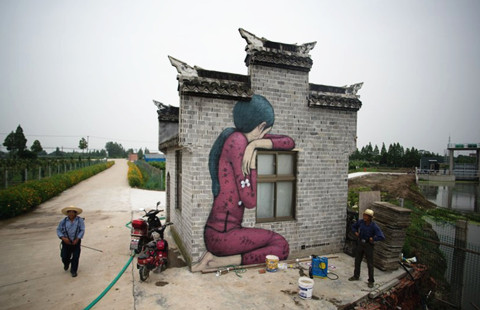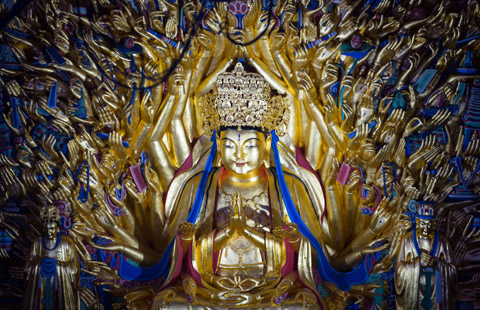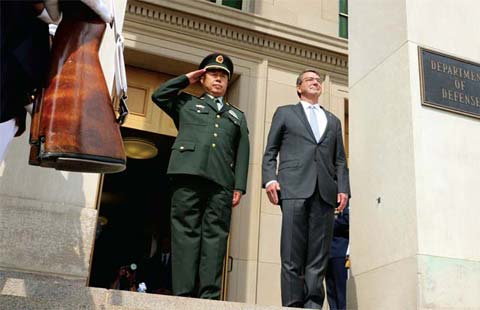Historians build links to an important historic past
Updated: 2015-06-09 06:24
By Chang Jun(China Daily USA)
|
|||||||||
Chinese railroad workers played a vital role in the 1860s construction and completion of the first transcontinental railway in the US. Their herculean efforts in helping to shape the physical and social landscape of the American West should always be remembered, and their heart-wrenching stories should be told and retold and passed on to future generations so that they are never forgotten.
On June 6, the research organization Chinese Railroad Workers in North America Project (CRRW) at Stanford University and the Chinese Historical Society of America (CHSA) jointly sponsored a seminar and exhibition entitled "The Chinese and the Iron Road: Building the Transcontinental" to commemorate the 150th anniversary of the introduction of Chinese workers to the first transcontinental railroad in America.
About 200 attendees — including the Chinese Consul General in San Francisco Luo Linquan; Richard Saller, professor in the School of Humanities and Sciences; and Gordon Chang, professor of history and director of the Center for East Asian Studies — shared their thoughts on the role Chinese railroad workers played in China-US history.
"These railway workers were pioneers not only in the history of Chinese immigration into the US, but also in the history of people-to-people exchanges between our two countries," said Luo. "The commemoration of Chinese railway workers is of great significance today as China and the US are enjoying a much closer relationship in all aspects."
Luo also praised the historic restoration and preservation efforts of the scholars at Stanford.
"This railroad research project will enhance mutual understanding between our two peoples, and help cement the China-US friendship," he said.
The history of the Chinese in the US from the 19th to early 20th centuries is a trans-national story that should be told from both the US and Chinese perspectives, said the organizers.
My personal knowledge of Chinese railroad laborers was enriched during a fact-seeking trip to Truckee three years ago. A two-hour drive from Sacramento, the small town impressed me deeply with its railway museum, which uses a caboose from the Southern Pacific Railroad to house storyboards, pictures and railroad artifacts and memorabilia depicting the creation and completion of the first transcontinental railroad in North America.
In the photographs on display, I spotted many familiar-looking faces among the Chinese laborers — those young Chinese men who came to the US in the 1860s and toiled at a grueling pace and under perilous conditions. They were forced to advance the railroad at least one mile a day. They worked as a team around the clock using hammers, chisels and black gunpowder to wind the tracks through the Sierra Mountains. They slept in snow-capped caves and filled their bellies with rotten potatoes and bread. They battled disease and discrimination thousands of miles from home.
Chinese railway workers earned the nickname of "masters" through their skills, dedication, teamwork, integrity and perseverance. Still their contributions to the railway were egregiously underappreciated and very little is known about these workers' lives and what happened to them after the construction ended.
Instead of being rewarded, Chinese immigrants were prosecuted under the Chinese Exclusion Act, which was signed by President Chester A. Arthur on May 6, 1882 and restricted immigration of laborers from China. The US Congress revisited the legislation five times between 1884 and 1904, imposing ever-tighter limits on Chinese immigration. The laws suspended immigration to the US from China and, for more than 60 years until its repeal in 1943, barred those already in the country from becoming citizens.
For years, a group of scholars at Stanford University has been working on the CRRW project in order to coordinate research in North America and Asia for the creation of an online digital archive to be made available to the public, including books, digital visualizations, conferences and public events.
Through CRRW's advocacy, the Society for Historical Archaeology recently published a special theme issue of its journal Historical Archaeology. Entitled The Archaeology of Chinese Railroad Workers in North America, it features 16 original articles, including never-before-published accounts of some of the earliest archaeological discoveries from Chinese work camp sites. The issue was developed through a Stanford University workshop in October 2013, sponsored and organized by the CRRW; the project's director of archaeology, Barbara L. Voss, served as guest editor.
It provides still another significant link with an important historic past.
Contact the writer at junechang@chinadailyusa.com.
- Indian practioners to celebrate World Yoga Day
- Indonesia volcano unleashes fresh burst
- DPRK fires 3 short-range missiles into eastern waters: Yonhap
- China, S. Korea pledge to lift strategic cooperative partnership to new high
- WHO advises S.Korea to ban all MERS suspects' overseas travel
- New cargo train service between China, Europe opens

 18th Shanghai Int'l Film Festival kicks off
18th Shanghai Int'l Film Festival kicks off
 Dancing grannies' costumes are a stunning surprise
Dancing grannies' costumes are a stunning surprise
 Bubble Run brings fun to Shenyang
Bubble Run brings fun to Shenyang
 French street artist finds inspiration in Shanghai village
French street artist finds inspiration in Shanghai village
 China restores 800-year-old Buddha statue
China restores 800-year-old Buddha statue
 High fashion goes vertical
High fashion goes vertical
 Across America (June 5-11)
Across America (June 5-11) Warriors top Cavaliers to square up NBA Finals
Warriors top Cavaliers to square up NBA Finals
Most Viewed
Editor's Picks

|

|

|

|

|

|
Today's Top News
China, US sign agreement to boost army cooperation
China steps up
MERS alert
Former Chinese top legislator Qiao Shi dies in Beijing at age 91
China has adequate fiscal space to absorb local govt debt risks
US defense chief invited to visit China this year
Hillary Clinton makes pitch to working Americans at big rally
Six state firms checked in graft battle
Uber plans to invest $1 billion in China
US Weekly

|

|







